In the emerging post-pandemic era, most aspects of life have returned to normal. Moviegoers are flocking to cinemas, vacationers jammed airports for summer travel and kids are returning to classrooms.
The one thing that has remained stubbornly fraught: the world of work.
Three-and-a-half years after millions of office-goers were sent home en masse, companies, employees and governments are still figuring out how to adapt to lasting changes to corporate life. But stark differences have emerged across continents and cultures, with Asian and European workers largely returning to offices at a faster pace than their counterparts in the Americas.
Asian nations did a better job keeping COVID-19 under wraps in the pandemic’s first year, so people there didn’t get as accustomed to working from home, making it easier to transition back-to-office life, researchers found. Europe’s habits vary widely—the UK has one of the highest rates of remote work, and France one of the lowest—but several of its countries also are leading the way with laws enshrining flexible schedules.
Then there are places such as the U.S., where policymakers have stayed largely silent, leaving bosses and employees to navigate the changes on their own. As the post-Labor Day period marks a time of resuming normal schedules after summer vacations, companies including Amazon.com Inc. and even Zoom Video Communications Inc. are cracking down on getting workers back to offices for at least part of the week.
But even then, workers are facing vastly different policies depending on their companies, managers or location. Goldman Sachs Group Inc. wants staff in five days a week. At Walt Disney Co., it’s four days; for Amazon, Google and many others, it’s three. Hybrid schedules are now the norm for office goers in the world’s largest economy.
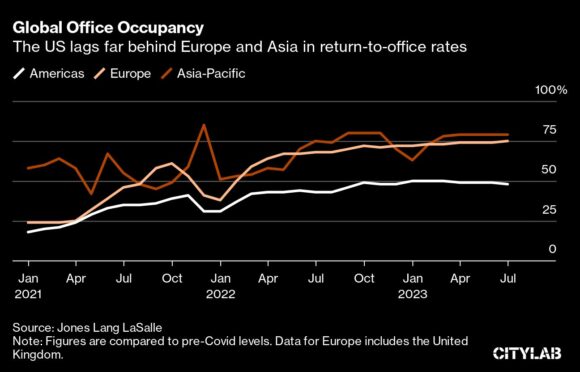
The chaotic nature of RTO was understandable two years ago, when COVID was still circulating at crisis levels and “the Great Resignation” and “lying flat” were the catchphrases of the day for workers pushing back on norms. Now, cooling economies mean hiring has slowed in many sectors from the frenetic pace of two years ago, giving bosses more leverage to call the shots, while layoffs and cost-cutting measures have many workers on edge. Yet the debate is far from settled, leaving questions about the role of offices, the integration of work and life, and the measurement of productivity and pay.
How it plays out carries significant economic consequences: McKinsey Global Institute estimates that pandemic shifts could erase as much as $1.3 trillion of real estate value in big cities around the world by 2030.
“Everyone is asking, ‘Is this going to come back?'” said Phil Kirschner, who advises executives on real estate and workplace strategies at McKinsey & Co. in the US.
“What we’ve done is Band-Aided some tools together to prevent the ship from sinking,” he said. “But we haven’t done the difficult work to say, ‘The way we were working before was not universally great for everybody. And this is the new reality.'”

Cultures, Commutes
It’s hard to cast entire continents as monolithic. The U.S. may have embraced remote work more than other regions, but more than half of American workers toil on the frontlines, without much of an option to work from home. In Japan, the nation’s largest lenders are eschewing a minimum number of office days per week, in contrast to their Wall Street counterparts. Unilever Plc, the European maker of Dove soap, allows desk-based workers a good deal of flexibility in both where and when they work, and has piloted four-day workweeks in several countries.
But both cultural and structural factors have contributed to regional variations, according to Phil Ryan, London-based director of JLL City Futures, part of the global research and analysis arm of the real estate firm Jones Lang LaSalle Inc.
“Some of it is absolutely cultural—some places have more expectations of people coming in,” said Ryan. “In some places it’s about reliable public transportation. Another big difference is home sizes; in the US, they have larger home offices so they don’t feel that the office is a better place to work.”
In Hong Kong, tiny apartments and an efficient public transport system have given residents fewer reasons to work from home. There, subway ridership surpassed 2019 levels in March and empty office space is more tied to decreased Chinese investment than remote work. In New York, subways are still only 70 percent full on weekdays and only about half of workers are back at buildings on a given day compared with pre-COVID levels.
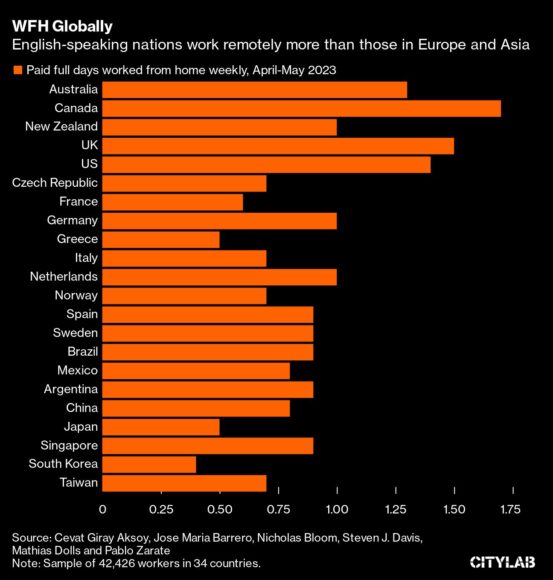
Working remotely has been generally more accepted and widespread in the U.S., according to Mark Mortensen and Henrik Bresman, professors at the INSEAD business school. That’s due in part to the preponderance of technology, finance and business-services roles—so-called “knowledge workers”—that are computer-intensive and thus more conducive to remote work. Americans in tech, finance and professional services work from home nearly a full day more per week than those in government and health-care roles, according to research from a team of economists including Stanford University economics professor Nicholas Bloom.
And this isn’t likely to change much: The research from Mortensen and Bresman found that the proportion of people in America who said their productivity while working remotely was at optimal levels was almost double that in the rest of the world. In contrast, a working paper on data-entry workers in India found those working from home to be 18 percent less productive.
Workers in Europe and Asia are more concerned about missing out on social connections with co-workers than Americans, Mortensen’s research found. Take Andrea Lovato, managing partner at F&P Equity Partners in Milan. He’s not against remote work, but says “in-person work has many more benefits: When you are sharing the same space in the office there is closer interaction with colleagues, a more spontaneous development of ideas and innovation, and higher engagement from people.”
Cities matter as much as culture, says Despina Katsikakis, the global head of real estate giant Cushman & Wakefield Plc’s workplace research and insights division. “Cities in Europe are more walkable and bring together work, life and play,” said Katsikakis, based in London. “So, European offices are more connected to blended, vibrant communities versus the US, where offices are more dictated by zoning laws and in more isolated areas.”
Space for Rent
The disparities have upended the commercial real estate market, where empty offices and the fastest pace of interest-rate hikes in a generation are leading to a debt crisis among some landlords. A McKinsey report in July explored the differences among cities, showing that office-heavy areas of New York and San Francisco have suffered steeper declines in real estate demand, alongside lower rates of office attendance, compared with cities like Paris and Munich. The consultancy estimated that about $800 billion may be wiped out from the value of office buildings in nine major cities in a moderate scenario, and as much as $1.3 trillion as a worst-case.
Places like Paris, along with many Asian cities, have cultures that value being present in the office. In Germany, 43 percent of the workforce spends four days or more in the office, according to a survey by workplace design firm Unispace. China’s high rates of office attendance are due in part to its so-called “996” culture, which involves working from 9 a.m. to 9 p.m., six days a week. Loyalty to employers is also more steadfast in places like Japan and South Korea, say, than in the US.
“The often-implicit assumption that the landscape looks similar across cultures and contexts does not hold up to scrutiny,” Mortensen said.
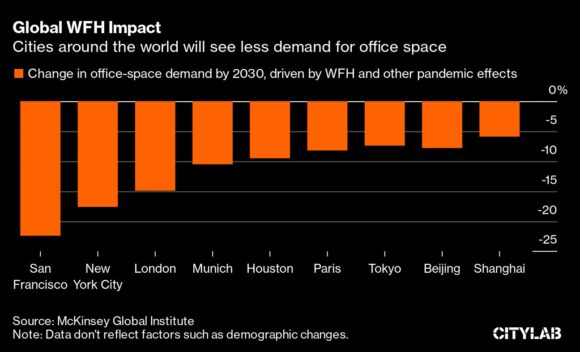
There are some global commonalities, though. Women place a higher average value on working from home than men in all but a few countries, according to Stanford’s Bloom, as do those with more education. And industry can sometimes trump geography, said Ben Waber, co-founder and president of Humanyze, which analyzes workplace collaboration data for dozens of large organizations worldwide. “A software company in Japan will look more like a software company in the U.S. versus a manufacturer in Japan,” he said.
Still, American firms tend to be more advanced in performance measurement and evaluation systems that are critical for remote work when managers can’t observe employees directly, according to research from a team including Italian economist Andrea Lamorgese.
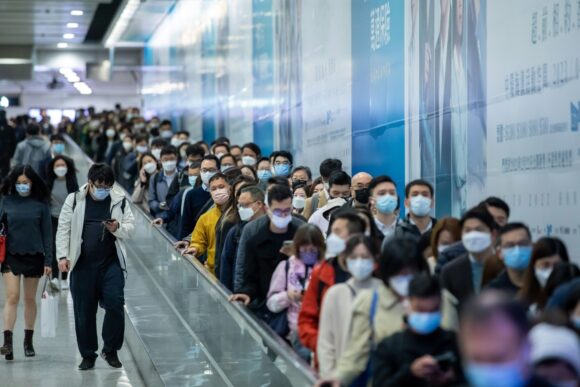
Legislative Efforts
In Europe, policymakers have stepped in to help shape the future of work by promoting more flexible arrangements. At least half a dozen nations have passed or proposed legislation to govern remote work, fueled by the European Union’s 2021 “right to disconnect” proposal, a call to grant EU employees legal rights to switch off from work-related tasks and electronic communication outside of normal business hours.
Already enforced in France, Spain and Belgium, the policy is backed by a majority of the European Parliament and could become EU law by the end of the year, according to Ben Marks, co-founder of the Future Workforce Alliance, a forum of politicians, business leaders and academics focused on policy changes.
Support for the right to disconnect goes well beyond Europe: Governments from Colombia to Canada have passed similar measures, and Kenya is considering it. Beyond that, the Dutch House last year passed a law to establish the legal right to work from home, and its Senate is expected to vote on it this year. The bill requires employers to consider employee requests to work remotely as long as their professions allow it, while insisting that the worker’s request be “reasonable and fair.”
The Netherlands ranks fifth globally in the number of remote jobs available, according to recent data from Lightcast and Revelio Labs, and some Dutch employers came to embrace flexible work during the pandemic.
Matthijs Welle, the Amsterdam-based CEO of Mews, which provides software for hotels, said he previously “never believed in work from home,” but now allows his 800 employees across 20 countries to work from anywhere after closing offices in half-a-dozen cities. “I think it’s needed to drive this conversation with more traditional managers, who have shut the door on it,” he said, referring to the legislation.
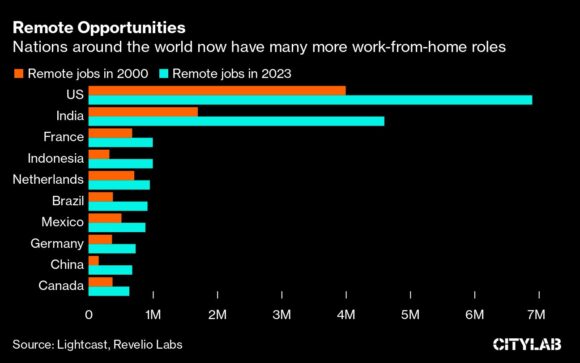
Ireland’s coalition government in April passed a similar remote-work law, which had been held up for months by claims that the bill was tilted in favor of employers. Millions of British workers, meanwhile, will soon have the right to request flexible working arrangements upon starting a job. Previously, they had to wait half a year before making such a request.
In Belgium, employees in February 2022 won the right to a four-day workweek at the same pay, and the coalition government there also introduced new rules for gig workers, setting out criteria for designating them as employees regardless of what they are called in their contract.

Off Hours
Critics of right-to-disconnect laws say such measures could be largely symbolic in today’s asynchronous workplace. Data from Microsoft Corp., maker of Teams collaboration and conferencing software, found a so-called “third peak” of productivity after 9 p.m. during the pandemic, with the average Teams user sending 42 percent more chats after hours compared with early 2020.
Then there are people who have moved to work remotely from entirely new locations, often logging on at unconventional times. During the pandemic, Lisbon and other Portuguese cities became a haven for digital nomads from the U.S. and elsewhere, who took advantage of favorable tax rates, cheap real estate and a generous visa, introduced in October, that allowed remote workers to live in the sun-speckled country for up to five years.
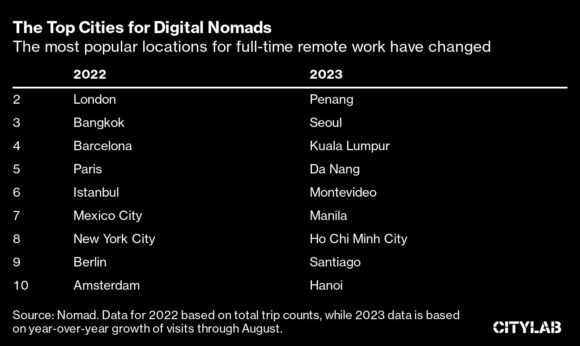
In six months, 930 such visas were granted, according to Portugal’s immigration department, with Americans receiving the most. Lisbon was the most-visited remote work hub in 2022, according to Nomad, a remote-worker network, but visits are down 32 percent so far in 2023. Rents and property prices in the capital city have ballooned, and in February the government announced it would end its “golden visa” path-to-citizenship program for foreigners who invest in real estate in the country. Ireland has done the same, and other European locales are becoming less welcoming.
In response, digital nomads are now looking outside the US and Europe — eight of the ten fastest-growing remote-work hubs in 2023 so far are in Asia, including Tokyo, Seoul and Ho Chi Minh City.
The Road Ahead
In the US, Labor Day has emerged as a marker of a renewed push toward stricter office-attendance policies, and this year is no different. At the World Bank in Washington, President Ajay Banga wants workers back four days starting this week. Even a company like Workhuman, which provides worker-recognition programs and prides itself on listening closely to employee concerns, has asked most of its staff to come back to offices twice a week beginning this month.
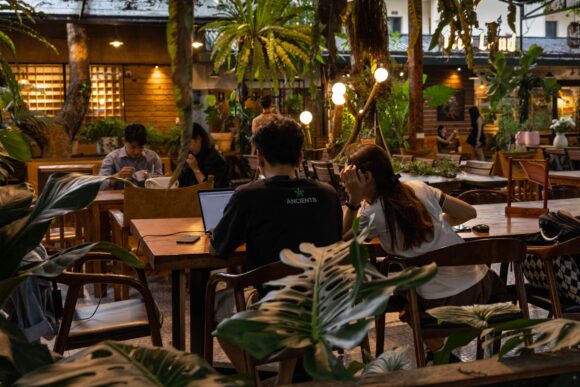
“The summer is wide open, then things normalize in September,” said KeyAnna Schmiedl, Workhuman’s chief human experience officer.
But any leader who keeps hoping things will get “back to normal” will be disappointed, because the workplace is fundamentally different now. Office occupancy rates have plateaued in the U.S. at half of pre-COVID levels. Lobbies are ghost towns on Fridays. Business leaders grumble about the effects of working from home, but they also know it’s now ingrained, according to a new survey by the Federal Reserve Bank of New York. Work is no longer a place people go, it’s a thing they do — and when, where and how it happens is no longer written in stone.
“COVID was a portal we walked through,” said McKinsey’s Kirschner. “And we’re not going back.”
–With assistance from Sarah Holder, Chiara Remondini, Irina Anghel, Cagan Koc, Morwenna Coniam, Joao Lima and Taiga Uranaka.
Top photograph: The UK has one of the highest rates of remote work. Photo credit: Jason Alden/Bloomberg





















 Legal Finance and Insurance: From Confusion to Collaboration
Legal Finance and Insurance: From Confusion to Collaboration  The Latest Launches from Allstate, WTW, Whisker Labs
The Latest Launches from Allstate, WTW, Whisker Labs  Chubb, The Hartford, Liberty and Travelers Team Up on Surety Tech Co. Launch
Chubb, The Hartford, Liberty and Travelers Team Up on Surety Tech Co. Launch  Executives on the Move at HSB, American Modern Insurance Group, AIG
Executives on the Move at HSB, American Modern Insurance Group, AIG 





